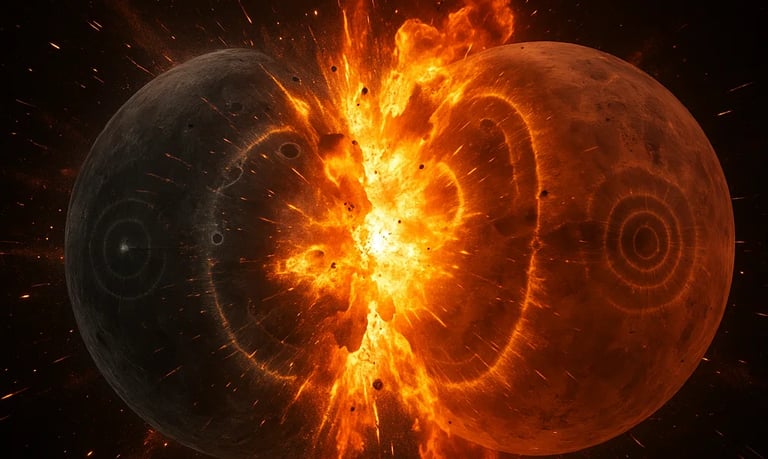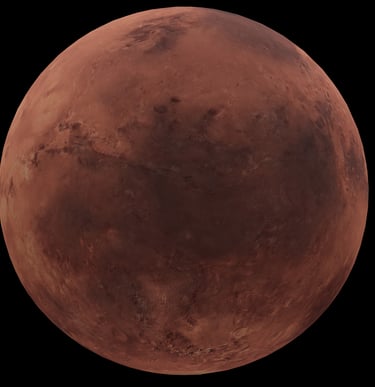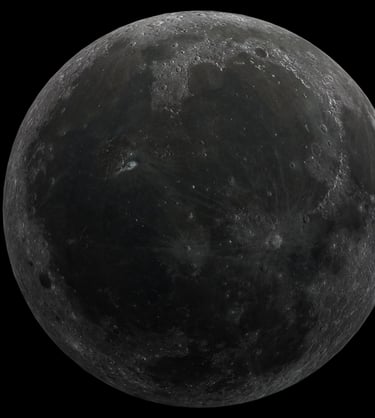Did Mars kill the dinosaurs?
7/21/20259 min read


Resonant Planetary Catastrophe Hypothesis: The Moon as a Free Body That Might Have Struck Mars and Then Been Captured by Earth
Did a collision with Mars bring Earth life, water, and a satellite?
Tharsis, Procellarum, Chicxulub — pieces of a single cosmic puzzle.
Main assumptions of the hypothesis:
The Moon may not have formed from material ejected from Earth, as stated by the Giant Impact Theory, but could have been an independent celestial body that took part in a series of catastrophic events in the inner Solar System. Around 66 million years ago, this body (today's Moon) might have struck Mars, potentially leading to: destabilization of Mars' core, loss of its atmosphere and magnetic field, deformation of the northern hemisphere (lower terrain, gigantic craters), cessation of geological activity. After the hypothetical collision, the Moon's trajectory might have been curved in such a way that Earth was able to capture it — at the same time: fragments of Mars' atmosphere and water molecules (frozen or gaseous) could have reached Earth. Earth might have gained additional mass and a new satellite.
Possible effects for Earth:
Atmospheric thickening — a sudden increase in pressure might have led to the suffocation of large organisms (dinosaurs) that were not adapted to the change in gas conditions. Beginning of plate tectonics — the outer mass of Earth's mantle might have cracked and begun to shift (beginnings of the current crust dynamics). Geological traces on Earth (e.g. Yucatán) might be only one of many signs of this global event.
Indirect evidence supporting the hypothesis:
Mars has an "impact scar" and a clear geological asymmetry, Earth and the Moon have strangely correlated rotational and orbital parameters. Earth's geological record contains many indications of sudden climate change, an increase in the planet's mass, and reorganization of the crust structure. Oceanus Procellarum on the Moon and Tharsis on Mars may be mutual "reflections" of the hypothetical collision direction. The asteroid belt between Mars and Jupiter might be the remnants of material ejected from Mars that did not reach Earth.
Criticism of dating the Mars collision based on meteorites:
Official science often points to the age of Martian meteorites (approx. 4 billion years) as evidence of a very early collision. However, the age of the rock does not have to be equivalent to the age of the event that tore it from Mars. The material might have come from old crust but been torn away as a result of a much later event — e.g. approx. 66 million years ago. The very fact that meteorites are still reaching Earth today may indicate that they were ejected relatively recently — and not drifting freely for billions of years. In this way, the 4-billion-year-old collision hypothesis could lose coherence, and the version about a late, resonant impact could gain credibility.
Mars' wounds – geology of a planetary blow:
Valles Marineris, often called the Martian Grand Canyon, might actually be a gigantic crack in Mars' crust formed as a result of a sudden loss of mass and thermal energy after the hypothetical catastrophe. This area does not bear the features of typical river landforms, and resembles a fissure in hardened crust stretching along a stress fracture line. The so-called riverbeds may in fact be solidified lava channels, and not water flow forms — this interpretation might have been rejected due to the assumption of Mars' geological inactivity. The abundance of iron oxides and the chemical composition of Mars' surface match the features of the planet's outer core — which would suggest that the catastrophe exposed the internal layers of Mars. The moons Phobos and Deimos have irregular shapes, low density, and unusual orbits — which could mean they are fragments of Martian crust or debris from the collision that were trapped in unstable orbits after the impact.
Tharsis on Mars and Oceanus Procellarum on the Moon – possible geological analogies:
An interesting aspect supporting the resonant planetary catastrophe hypothesis is the similarity of two enormous basaltic regions on Mars and the Moon, which may be the result of the same mechanism – a sudden weakening and stretching of the crust due to a massive mechanical impulse.
Tharsis on Mars:
This is a vast volcanic province covering an area with a diameter of approximately 4000 km. It contains some of the largest volcanoes in the Solar System (Olympus Mons, Arsia Mons, Pavonis Mons, Ascraeus Mons) as well as a system of rifts and depressions (Valles Marineris). This entire structure is raised several kilometers above Mars' average level and is characterized by gravitational anomalies and a very thin crust in some places. This may indicate that in the past, Mars experienced enormous stress or a "side impact" that in turn opened the crust and allowed for massive basalt outflows from the planet's interior.
Oceanus Procellarum on the Moon:
This is a vast, dark basaltic region stretching from near the equator far to the north, with a diameter of approx. 2500 km and a surface area of approx. 4 million km². It is filled with thick layers of lava that flowed onto the surface after prior crust weakening. It is not a classic impact crater – geophysical studies suggest that the crust under Procellarum is thinner, and the area itself contains unusual gravitational anomalies. This may mean that it formed as a result of deep stress or a resonant shock that damaged the crust and opened a path for basaltic lava.
Possible shared mechanism:
Hypothetically, these two gigantic basaltic regions may be geological "equivalents", formed by the same process: a strong resonant interplanetary impulse, an impact or graze that stretched the crusts and led to their weakening, which in turn allowed powerful lava outflows from within these celestial bodies. This would explain why both Tharsis and Oceanus Procellarum are enormous in size, basaltic in composition, and associated with gravitational anomalies.
Chemical connections linking Mars to the K–Pg boundary layer on Earth:
In the K–Pg layer, dated to approx. 66 million years ago, globally elevated concentrations of iridium (Ir) — elements rare in Earth's crust but common in meteorites — were found. Importantly, iridium is also present in meteorites of Martian origin, which might suggest a common material source or a collision involving Mars. The K–Pg layer also shows high content of sulfur compounds, which could have come from vaporized sulfates during the impact. Martian meteorites also contain sulfides, which might indicate deep chemical kinship. Additionally, some Martian meteorites contain aromatic hydrocarbons and simple organic compounds — which may suggest that the basic components of life could have been transferred to Earth as a result of this collision. Also, microtektites and impact glasses present in the K–Pg layer are consistent with extreme impact conditions and could indicate material of extraterrestrial origin. Shared elements such as calcium, nickel, chromium, or titanium, present in both Martian meteorites and Earth's impact layer, would further reinforce the hypothesis of shared history and matter transfer between planets.
Moon’s original orbit and the collision mechanism with Mars:
The object that currently plays the role of the Moon might have originally been in orbit in the area of the current asteroid belt. During the formation of the Solar System, its trajectory could have been disturbed by Jupiter, which through strong gravitational influence stripped it of some mass. This object, slimmed down and with an elongated orbit, could have entered a path crossing Mars’ orbit. Instead of a central impact, there might have been an oblique collision or a graze — which would explain the asymmetrical surface damage on Mars and the presence of lunar collision traces (e.g. Oceanus Procellarum). Such a scenario would not only have changed the fate of Mars, but also placed the Moon on a trajectory allowing it to be captured by Earth.
Hypothetical consequences: capture of mass and life:
It cannot be ruled out that part of the atmosphere, minerals, and even biological particles (e.g. DNA, RNA, bacteria or their ancestors) could have been transported from Mars to Earth as a result of this collision. It is possible that some forms of life that originated or developed on Mars in its moist, warmer past survived in meteorite material and became the seed of Earth’s biosphere. Additionally, the increase in Earth’s mass through the capture of part of this matter might have accelerated its geological maturation and created conditions favorable for the rapid development of life.
Multiple impacts as a result of the collision with Mars:
More and more geological data suggests that the Cretaceous extinction was not caused by a single impact, but by a series of coordinated or temporally close impacts. In addition to the main Chicxulub crater in Mexico (~180 km in diameter), other structures have been discovered and dated:
Shiva (India) – a supposed structure up to 500 km in diameter,
Boltysh (Ukraine) – a confirmed crater 24 km in diameter,
Nadir (off the coast of Africa) – a recently identified crater (~8.5 km), also dated to 66 million years ago,
Silverpit (North Sea) – ~20 km in diameter, similar age,
The temporal convergence of these impacts might mean that this was not a rain of independent asteroids, but the result of the disintegration of a larger body. The hypothesis assumes that the original Moon, after colliding with Mars, partially broke into fragments, of which: a larger core was captured by Earth as the present Moon, and numerous fragments might have struck various parts of the planet. Such a scenario would explain the variety of sizes and distributions of craters, and the fact that many of them show signs of similar geological age. Fragmentation from an interplanetary collision and the later dispersion of their trajectories could have resulted in dozens of impacts over thousands or hundreds of thousands of years — which would be enough to cause mass extinction. Such a scenario could link physical, chemical, and biological processes into one sequence of events: a resonant interplanetary impulse as a potential source of life, mass, and climate.
Excess water on Earth – a potential source from Mars:
Modern models of planet formation suggest that Earth may have an unnaturally high water content, disproportionate to its mass and position in the Solar System. Water should have been pushed out to the outer regions of the Solar System by the young, intensely radiating Sun, making the presence of such large oceans on Earth difficult to explain. The hypothesis suggests that original Mars was significantly larger than today and had substantial amounts of water bound in the crust, atmosphere, and mantle. Mars’ mass loss due to the collision with the future Moon might have amounted to 1/4 to 1/3 of its original mass, making it a potential source of Earth’s water. Fragments of crust, ice, and water vapor might have been ejected into space, forming an asteroid belt, part of which could have reached Earth. Additionally, these fragments could have been rich in water and other volatile substances, which might have increased the total amount of water on Earth after accretion. The capture of the Moon might also have introduced significant amounts of volatile substances into Earth's atmospheric system. This could explain both the unexplained excess of water on Earth and the unusual chemical composition of Earth’s atmosphere and its relatively high humidity compared to other rocky planets.
Hypothetical consequences: capture of mass and life:
It cannot be ruled out that part of the atmosphere, minerals, and even biological particles (e.g. DNA, RNA, bacteria or their ancestors) could have been transported from Mars to Earth as a result of this collision,
It is possible that some forms of life that originated or developed on Mars in its moist, warmer past survived in meteorite material and contributed to significant biological changes on Earth,
After this hypothetical collision, there might have been enormous changes in existing life structures on Earth — entirely new forms appeared that had not been observed before or had existed only in minimal numbers,
Some paleobiological theories suggest that the sudden appearance of groups of organisms with completely new traits (e.g. altered protein structures, new metabolic systems or even fundamental RNA/DNA replication mechanisms) could be related to the delivery of unique genetic patterns from beyond Earth,
Additionally, the increase in Earth’s mass through the capture of part of the matter might have accelerated its geological maturation and created conditions conducive to dynamic life expansion in new directions, which in turn could have led to the development of entirely new ecosystems.
Summary:
This expanded resonant planetary catastrophe hypothesis presents an alternative scenario for the origin of the current Earth–Moon system and deep changes in Earth’s geological and biological history. It assumes that the Moon may have been an independent body that, due to orbital disturbances initiated by Jupiter, entered a collision course with Mars, causing its deformation, loss of part of its mass and atmosphere, and the formation of gigantic structures such as Tharsis. This object could then have changed orbit and been captured by Earth as the present Moon.
As a result of this process, part of the Martian material, along with water and potential organic compounds, might have been transported to Earth, influencing the development of the biosphere and increasing the planet’s mass. A series of fragment impacts might have been responsible for scattered craters and the mass extinction at the end of the Cretaceous. Altogether, this might represent one great resonant reaction of the Solar System that ultimately initiated the current state of Earth, the Moon, Mars, and the asteroid belt. In this way, physical, chemical, and biological processes intertwine into one coherent story that could explain many of the Solar System’s unknowns.
Disclaimer:
This is solely a hypothesis and my personal vision, although largely based on available data and observations, it should not be treated as a scientific source or definitive proof. It is rather an attempt at personal interpretation of phenomena and a free concept that requires further research and verification.


Mars – Tharsis
Vast volcanic region about 4000 km in diameter. Includes Olympus Mons and the largest volcanoes in the Solar System. Elevated area with gravitational anomalies. Source: NASA


